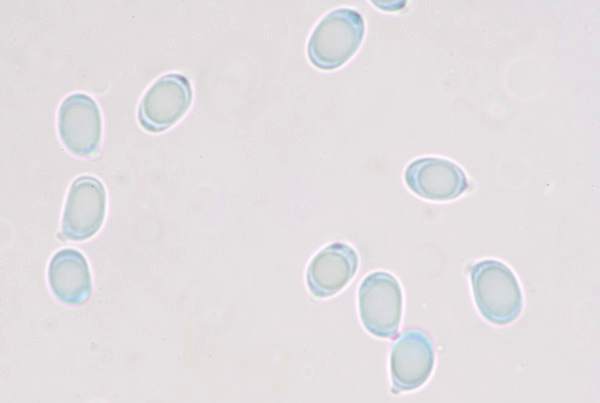Amanita rubescens Pers. - Blusher
Phylum: Basidiomycota - Class: Agaricomycetes - Order: Agaricales - Family: Amanitaceae
Distribution -Taxonomic History - Etymology - Toxicity - Identification - Culinary Notes - Reference Sources
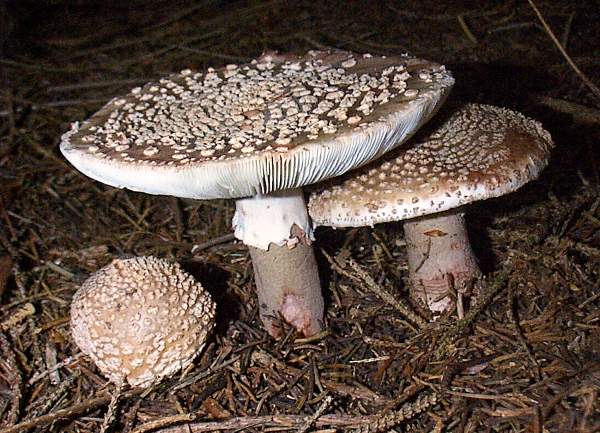
Cap colour is no clue at all to the identity of this large and very common mushroom. Blusher caps vary from from almost white through various shades of pink and brown to almost black. And yet there is something about a Blusher that betrays its identity to anyone who has seen them before. They blush when bruised or cut.
Amanita rubescens f. annulosulfurea is a form of Amanita rubescens that has a sulphur-yellow stem ring; there are no other characteristics differentiating it from other Blushers.
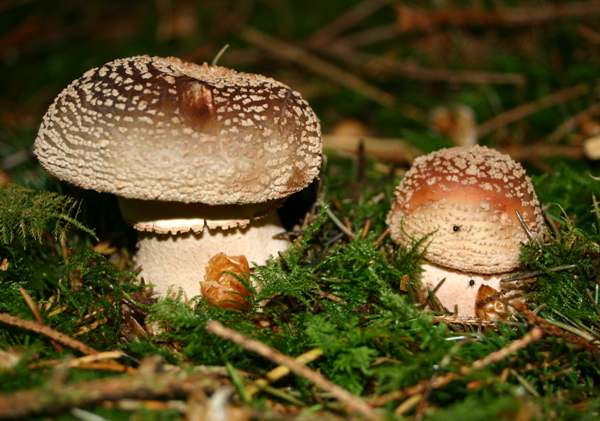
For a detailed description of the Amanita genus and identification of common species see our Simple Amanita Key...
Distribution
Amanita rubescens is very common and widespread throughout Britain and Ireland as well as in mainland Europe and in North America. (Many authorities believe that Blushers found in the USA are a different species from the European Blusher.) In South Africa, where Amanita rubescens is also recorded, it is thought to be an introduced species rather than a native one.
Taxonomic history
This species was named and described by Christiaan Hendrik Persoon in 1797.
Etymology
The specific epithet rubescens means reddening; it refers to the colour change from white to pinkish red when cut or damaged flesh of either the cap or the stem is exposed to air. The English common name is equally direct.
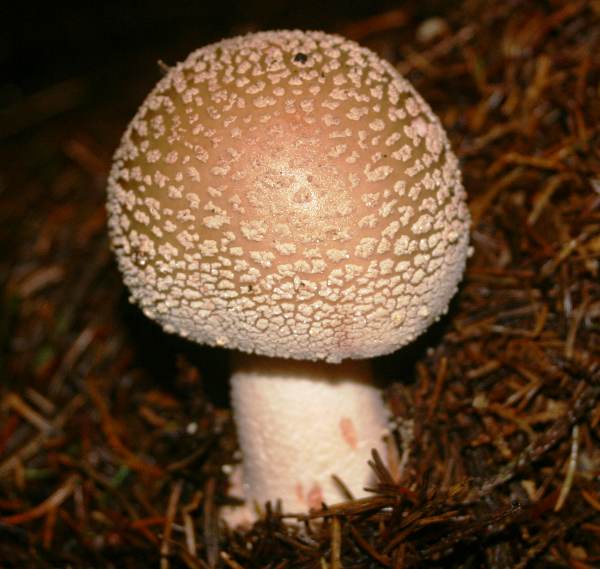
Toxicity
Unlike many amanitas the Blusher is generally considered edible if well cooked; but, since it is known to contain a hemolytic toxin in its raw state and hence causes anaemia if eaten raw, most people steer clear of it as a food source. (The toxic compounds concerned are destroyed if Amanita rubescens is cooked thoroughly.)
One of the biggest challenges for anyone trying to identify this very common member of the Amanita genus is its tremendous varability. I have found fully mature Blushers with caps no larger than 2.5cm in diameter, while others attain nearly ten times that size.
Equally variable is the cap colour. Some Blushers have a reddish background, some are brown, and others, like the specimen shown above, can only be described as a bright metallic silver.
Identification guide
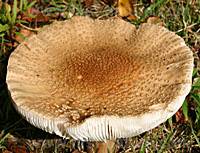 |
CapBlusher caps range from 5 to 20cm diameter when fully expanded; often brownish-pink but very variable; usually retaining irregularly distributed, off-white or grey fragments of the universal veil; initially domed, but flattening at maturity and occasionally becoming slightly funnel-shaped. When damaged, the gills and cap flesh turn deep pink or dull red. In very wet weather the veil fragments may get washed from the cap, but the reddening of any damaged areas of an Amanita rubescens mushroom is always an aid to identification. |
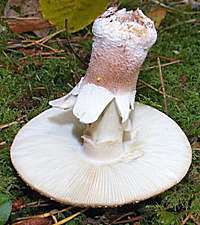 |
GillsGills of Amanita rubescens are white, adnate to almost free of the stem, and crowded. In mature Blusher specimens the gills are often marked with pink or rusty red spots, and when handled the gills very quickly blush pink or dull red. StemBlusher stems are usually between 7 and 15cm in length; stem diameter is typically 1 to 2cm; white above the stem ring but reddish-brown, often with deep pink flecks, below the stem ring; the stem flesh bruises pink when cut. The stem becomes hollow with age and bears a hanging stem ring that is quite thin and fragile, usually grooved, and often ragged. The volva of Amanita rubescens is visible only on very on immature specimens. As the fungus matures the volval remains disappear leaving a swollen base without any distinct basal rings. |
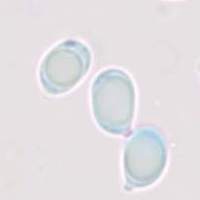 |
SporesBroadly ellipsoidal to ovoid, smooth, 8-9 x 5-5.5µm; amyloid. Spore printWhite. |
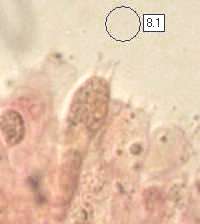 |
Basidia4-spored. |
Odour/taste |
Neither the odour nor the taste of fresh Blusher mushrooms is distinctive, but like most fungi once infested by maggots, to which they are rather prone, old fruitbodies can smell quite unpleasant. |
Habitat & Ecological role |
Blushers are mycorhizal with hardwood and softwood trees; they are particularly abundant in many conifer forests on poor acidic soils, where they occur in small groups more often than singly. |
Season |
June to October is their main season in Britain and Ireland, but occasionally Blushers appear during mild spells as late as December. |
Similar species |
Amanita excelsa (synonym Amanita spissa), the Grey Spotted Amanita, is referred to by some authorities as the False Panthercap; it could equally be termed the False Blusher because, apart from displaying unchanging flesh colour when cut, quite a high proportion of specimens look remarkably similar to some colour forms of the Blusher. Amanita caesarea (Caesar's Mushroom) is rarely if ever found except in southern Europe; its cap is brilliant orange with a striated margin, and the stipe is yellow - Blusher caps lack marginal striations and their stems are not yellow, although there is a form - Amanita rubescens f. annulosulfurea (Gillet) Lange - that has a yellow stem ring. The caps of some samples of Amanita muscaria are orange-brown while others are silvery, but the veil fragments are pure white rather than grey or off-white tinged with pink or brown. Amanita pantherina has a brown cap with white veil fragments; its flesh does not blush pink when damaged. |
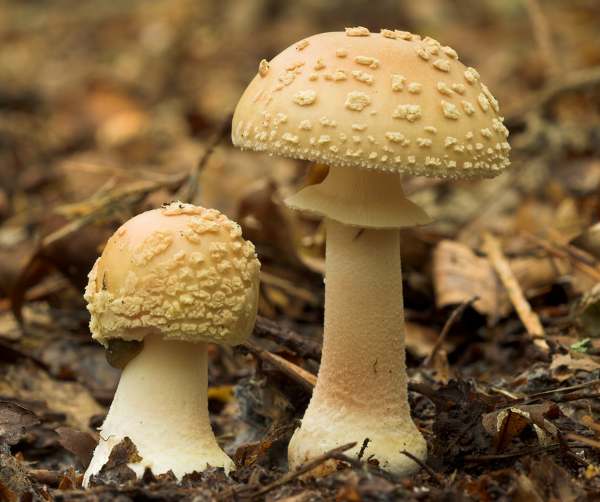
Culinary Notes
Few wild mushrooms can safely be eaten raw. Blushers must be thoroughly cooked, otherwise it can cause serious illness. We do not recommend this species in any of our mushroom menus.
The pale Blushers shown above were ptotographed in the New Forest, Hampshire, England by Dave Kelly; contrast them with the darker specimens, below, found in West Wales.
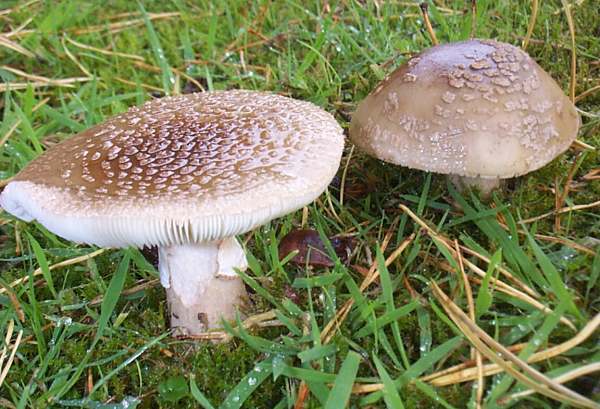
Reference Sources
, Pat O'Reilly, 2016.
Funga Nordica: 2nd edition 2012. Edited by Knudsen, H. & Vesterholt, J. ISBN 9788798396130
Geoffrey Kibby, (2012) Genus Amanita in Great Britain, self-published monograph.
BMS List of English Names for Fungi
Paul M Kirk, Paul F Cannon, David W Minter & J A Stalpers (2008). Dictionary of the Fungi; CABI
Taxonomic history and synonym information on these pages is drawn from many sources but in particular from the British Mycological Society's GB Checklist of Fungi.
Acknowledgements
This page includes pictures kindly contributed by David Kelly.
Fascinated by Fungi. Back by popular demand, Pat O'Reilly's best-selling 450-page hardback book is available now. The latest second edition was republished with a sparkling new cover design in September 2022 by Coch-y-Bonddu Books. Full details and copies are available from the publisher's online bookshop...
